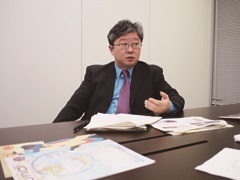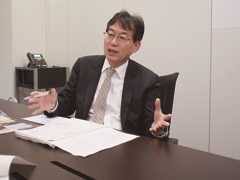The Asian Development Bank (ADB), Japan's long-standing partner in supporting Asian countries, is celebrating its 50th anniversary this year. Chief Economists of both JICA and ADB look back on the past five decades in Asia and discuss the future of the region.
OVERVIEW OF THE ASIAN ECONOMY
Hirota: Until recently, developed countries were facing long-term economic stagnation while emerging countries' economic growth is slowing down. I would like to hear your forecast for the Asian economy.
Sawada: According to the latest issue of ADB's Asian Development Outlook, the economic growth rate of Asia in 2016 was 5.6%. This is higher than that of the world or than the average of all emerging countries. In other words, Asia continues to be the key driver of the global economy.
Hirota: Trade is an important factor for economic growth of Asian countries. In the past few years, growth in global trade volume has been stagnant. How do you see this?
Sawada: Trade and foreign direct investment contribute to the improvement of production capacity in developing countries in the mid- to long-term, as they involve importing more advanced capital goods and technology transfer. From a long-term perspective, it is crucial to promote trade and investment ties between developed countries and Asia. Given the importance of trade and investment for Asia's prosperity, the rising trend against trade openness, and the potential reversal of decades of integration, this is something I am paying close attention to.
Hirota: Regarding foreign direct investment, we must also keep in mind that entry of foreign firms does not automatically mean technology transfer and productivity improvement. It is necessary to improve the capacity of human resources in emerging countries as the foundation to utilize new technologies. The meaning of technical cooperation lies in human resource development.
Sawada: Exactly. What's vital is to improve the absorptive capacity of Asian economies, the main beneficiaries of investment and technology transfer. Over the years, JICA has promoted technology transfer through technical cooperation, and at the same time, has put emphasis on the development of human capital.
Hirota: The ASEAN Economic Community was established in December of 2015. The importance of regional integration is increasing and JICA is promoting economic liberalization through technology transfer to contribute to economic growth. Now China is shifting its growth engine from investment and export to domestic consumption. What is your view on the future of the Chinese economy?
Sawada: China's economic growth rate dropped to 6.6% in 2016 compared to 9.5% in 2011. Behind this drop is China's rebalancing of the economy and we could say that the rebalance is similar to what happened in the 1970s in Japan. In addition, the Chinese economy is suffering from the similar "excess" factors as Japan did in 1990s such as overcapacity and high levels of debt. The government must find a path to a soft landing from rapid growth to slower growth.
TRANSITION OF ASIA AND ASSISTANCE FOR ASIAN COUNTRIES
Hirota: ADB has marked its 50th anniversary since its foundation. Fifty years ago, which is the late 1960s, was the time when South Korea's rapid economic growth started. Later, the Chinese economy started to develop after the introduction of the economic reform and liberalization policy in 1978, which was followed by dramatic growth in the 1990s. In Southeast Asia, ASEAN's lower income countries have been experiencing high economic growth since 2000. Looking back on the past 50 years, how do you see Asia's growth history?
Sawada: In the past 50 years, Asia has grown rapidly and reduced poverty dramatically. It was possible because both agriculture and non-agricultural sectors improved their productivity while the countries shifted the core of their industrial structure from the former to the latter. The success of the Green Revolution enabled increased food production and reduced concerns about starvation. Because of that, the agriculture sector's labor force was released into the non-agricultural sector, and both sectors achieved organic growth, benefitting people widely. You must also remember that physical infrastructure, human resources, and a stable macro economy provided a foundation for such development. This kind of inclusive growth, which involves a shift of the industrial structure, took place first in Japan and then in other East Asian countries. You can also find this type of growth pattern in Southeast and South Asia.
Hirota: I would like to keep a close eye on the patterns of Asia's development to see if such a shift from agriculture to manufacturing will continue in the years to come. Since the 2000s, India has also been growing significantly. How do you see the development of South Asian economy?
Sawada: In India, the IT sector and the manufacturing sector are developing and human resources are also accumulating. In Bangladesh 30 years ago, almost all development indicators were very poor. But due to factors such as growth in the ready-made garment industry, the country is now a role model for other developing countries. The garment industry is labor-intensive and it has a high capacity to absorb the female labor force. Although countries in the region have risk factors, such as vulnerability for natural disasters, the overall outlook for South Asia is promising.
Hirota: India has been experiencing economic growth led by domestic demand. That's what is different from China in the past. Over the five decades, how has Japanese assistance for Asian countries changed?
Sawada: It is worth looking at the change in Japanese assistance from the perspective of long-term change in the form of finances that flow into Asia from developed countries. In the 1970s, the early period of development, ODA played a major role. But gradually, financing forms such as foreign direct investment and indirect finance like bank loans have increased. Thailand's eastern waterfront area is now a major hub for Asia's manufacturing and auto industry. It was made possible by Japanese ODA, which was used to develop basic infrastructure there. It gave a foothold for the private sector to enter and the manufacturing industry to develop. In other words, this is a successful example of development through a "three in one" package comprised of ODA, investment, and export. Behind this success, I think, there lies integrated utilization of different types of assistance including technical cooperation, which promoted the development of human resources and industries, and assistance from bilateral agencies and international organizations. On the other hand, the importance of assistance does not necessarily decrease even if the industrial structure advances. This is because new risk factors such as financial crises and environmental issues emerge as an economy develops. Assistance is also needed to address such problems.
Hirota: Japan has provided support for Asia in establishing industrial foundations through infrastructure development as well as agriculture development. ADB is an important partner to Japan in providing assistance for Asia. ADB and JICA have developed a close, collaborative relationship in areas that range from analysis of development agendas to project implementation. Over the past years, the demand for infrastructure in Asia has been growing rapidly due to Asia's economic growth. Under the "Partnership for Quality Infrastructure" announced by the Japanese government, ADB and JICA signed a Memorandum of Understanding to strengthen their ties. This collaborative relationship will grow even stronger beyond infrastructure development. So, what do you think about our assistance for Asia in the future?
Sawada: Economic activity through markets is the basis for economic growth. However, it is difficult for developing countries by themselves to adjust to market failures. This is one of the reasons that aid agencies such as JICA and ADB exist and cooperate with these countries. While maintaining the development of physical infrastructure as one of their core activities, aid agencies are expected to support economic activities more broadly, including the development of all kinds of public mechanisms such as social infrastructure and financial and judicial systems. Japan has many experiences that can be shared with Asian countries, namely, dramatic recovery from World War II, the introduction of urban planning and anti-pollution measures during its rapid-growth period, and the development of countermeasures against economic crises, natural disasters, and an aging society. Japan must be able to provide assistance using this experience. Particularly through collaboration with ADB, Japan can contribute significantly to the achievement of the Sustainable Development Goals (SDGs) in Asia.
Hirota: Fifty years ago, Asia was one of the poorest regions in the world, along with Africa. Now, as many Asian nations have become more developed, new problems such as urban issues and financial instability are arising. I think the experiences of Japan as a developed country dealing with these new problems can be applied in many countries. I would like to continue making the most of Japan's strengths, in collaboration with ADB.
Notes
-
[1]Sawada Yasuyuki
Dr. Sawada is a Chief Economist at ADB. He has held positions as Associate Professor and Professor at the Graduate School of Economics at the University of Tokyo and has served as a consultant at the World Bank Development Research Group, a visiting professor at Stanford University's Center for International Development, a visiting researcher at the ADB Institute, and a visiting fellow at the JICA Research Institute.
Dr. Sawada was a professor at the University of Tokyo at the time of this interview.
-
[2]Hirota Koki
A Chief Economist at JICA, Dr. Hirota has been engaged in Japan's official development assistance (ODA) programs for 35 years. He has held various positions at JICA including Director General of Operation Strategy and Director General of Southeast Asia and the Pacific. He is currently a visiting professor at Saitama University in Japan.






scroll